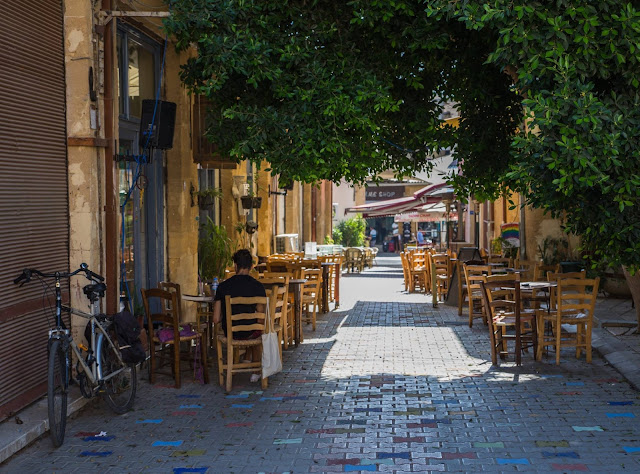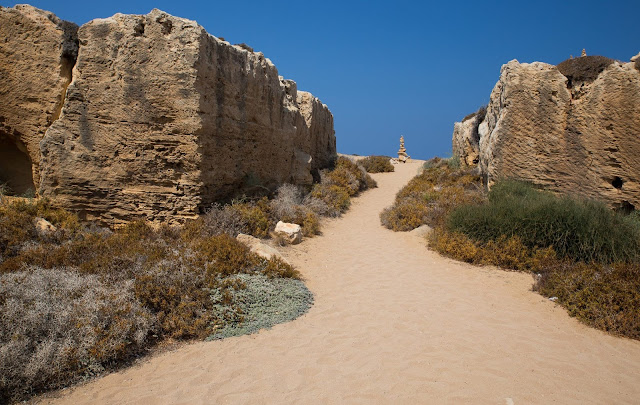 |
| Paphos, Cyprus |
 |
| View from the balcony of Agrohotel Ambelikos in the mountains |
Fun in the sun
We visited the island mid-August and had basically non-stop sunshine every day. The beaches varied almost dramatically from almost white sand to sky high cliffs but also dirt and all sorts of trash that washed up on the shores.
We flew to Larnaca and were planning to stay there for six days as we expected it would offer us a slightly more authentic experience than, for example, Agia Napa. To be honest, I wish we had chosen Limassol instead of Larnaca. Our AirBnB apartment on Stasinou turned out to be quite awful and even though we were really trying to stay positive, we ended up leaving after staying only two days. We were also quite happy to leave Larnaca as it turned out to be quite a boring place that just didn't offer much. The beaches were quite lousy, the sand had the color of mud and was dirty. Aside that, there wasn't much to see!
 |
| Larnaca after sunset |
On the second evening in Larnaca, as things really escalated with our AirBnB host, we decided to leave the apartment on Stasinou street. No warm water and cockroaches crawling around was really not something we signed up for. Luckily we had AirBnB on our side, which made it easy to leave. However, finding a hotel during the peak travel season when almost every single hotel was sold out was not an easy task! Even though we tried to avoid Agia Napa, because of it's reputation as the party capital of the island, we ended up not far from it, in a small town called Pyla.
 |
| Enjoying the sea view at Lordos Beach Hotel in Pyla |
On arrival the receptionist at the hotel told us that we are immediately upgraded to a better room as they are all sold out. Needless to say, we were happy. So we got to the room with a nice sea view and after 30 minutes we got a call from the reception, telling us that we will once more be upgraded to another room as they need to do electricity maintenance in the current room. So we get our stuff and move to a wonderful room with an even better view and two balconies. Yes, we were very happy. The hotel was indeed absolutely full (mainly full of families with small children, which usually isn't what we go for) but I must say that it turned out great. Going from a really dodgy AirBnB rental to a double-upgrade truly felt like the travel gods were on our side.
 |
| Amazing scenery in Famagusta |


Later we drove to Kissonerga, not far from Paphos. The beaches there were nice, there were less tourists and the sand was generally nicer, beaches were cleaner. Snorkeling was ok, but the variety of sea life was better in Famagusta. Also, there were more waves so you need to be a good swimmer. However, we found some beautiful, almost empty beaches and rocks by the sea that offered amazing views and privacy to escape the crowds.
 |
| Erdo III Shipwreck |
 |
| Nature everywhere! |
The cities - where to stay
As I've already mentioned, skip Larnaka. While we didn't actually stay in Limassol, we drove through the city and hoped we had stayed there instead of Larnaca. Limassol seemed much cleaner and better maintained. Also the beaches were generally nicer.
While Limassol seemed nice, we would recommend Paphos instead. Some of the smaller towns west of Paphos were tourist villages lacking authenticity but Paphos was actually quite nice, offering the usual services for tourists but you also get to experience the local vibe. Also, it's near some great beaches.
We visited Agia Napa on three different occasions as we had to drive through the city to get from Pyla to the Blue Lagoon and the Love Bridge (a natural stone arch, very pretty). Agia Napa was truly a world of it's own and we felt like we were thrown into a Jersey Shore episode. No matter what time of the day it was, and we were there once early in the morning before sunrise, then around noon and later in the evening, it looked like a club around the closing time, on all times.
 |
| The Love Bridge |
In Paphos you can visit the famous Tombs of the Kings (oldest ruins were from 4th century BCE). Even though we normally love Greek and Roman sights, these didn't seem so significant for us. From the archaeological aspect it is a beautiful place to visit but I wouldn't necessarily build the holiday around visiting this site.
 |
| Inside a tomb |
Nicosia turned out to be a bit of a disappointment. We do recommend driving to the capital of Cyprus but the main sights were not so significant and I think that our visit to the Turkish side was the highlight of the trip. We felt that the people were nicer in Nicosia, the food was better, but it was very small. Also, the trip across the border was very interesting. As soon as we stepped to the other side, it felt like we were back in Turkey. The difference was really that big.
 |
| Nicosia |
 |
| Nicosia, the Turkish side |
 |
| Nicosia |
Our favorite place of all was definitely the tiny village of Potamitissa in the mountains. The drive was absolutely beautiful, everything was clean and the people were genuinely friendly. The food was so much better up in the mountains than anywhere on the coast. Unfortunately I fell ill during the trip and had to stay in bed all three last days of our trip. So no hiking for us, but I must admit it was the best place to be sick in bed because the air was clean and slightly cooler and we had a wonderful hotel with amazing staff.
 |
| Agrohotel Ambelikos in Potamitissa |


 |
| Dine with the locals in Agros |
 |
| Village of Potamitissa |
Best of Cyprus
The Blue Lagoon and the Love Bridge, Agia Napa, Famagusta
for snorkelling and photography
Aphrodite's Rock, Paphos
for swimming and photography
Erdo 3 Shipwreck, Paphos
for photography
The rocky shore east of Paphos
for swimming and snorkelling
The mountains and especially Agrohotel Ambelikos
for hiking, food, culture, nature
 |
| There's always time for a selfie |
If you got the impression that we weren't especially amazed by Cyprus, you are right. While it's not a bad place for a holiday in the sun, we felt it was way too touristic for our taste. We definitely tried to find places that had a bit more of that real, authentic local vibe, we often felt disappointed. The island lives off tourism but there is so much to improve in all areas, especially in the coastal regions. Being on an island in the middle of the Mediterranean sea you would expect to get some delicious seafood yet none of the seafood we ate tasted particularly fresh or that well made, at least when you compare it to any of the other Mediterranean seaside regions. We also found that while Cyprus isn't an expensive destination at all, the hotels were over priced and you couldn't get a good value for money.
 |
| Edro III Shipwreck |




































